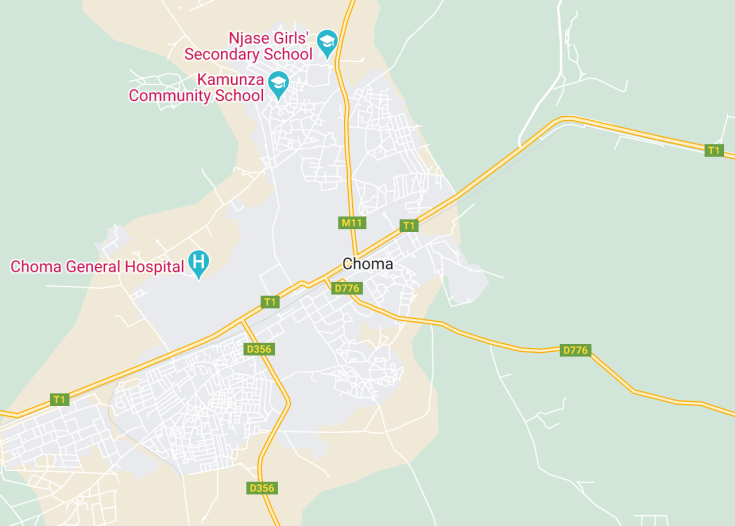Choma, the capital of the Southern Province of Zambia, is a gateway to understanding the rich cultural heritage and history of this part of Africa. This town not only acts as a commercial hub but also houses the Choma Museum and Crafts Project, dedicated to the arts and culture of the Tonga tribe. Visitors are invited to explore extensive galleries and vibrant marketplaces, offering an immersive experience into traditional craftsmanship and the everyday lives of the local people.
Before visiting Choma, be sure to check out the local event calendar; attending a cultural festival or local market can greatly enrich your experience.
Plan to visit during the dry season from May to August, as this will offer more comfortable travel conditions and clearer paths for exploring the surrounding landscapes.
Top things to do & see in Choma
Select the following sights and activities to discover best tickets and tours available in Choma.
Choma: Gateway to Southern Zambia
| Country | Zambia |
| Time in Choma | GMT+2 |
| Language spoken | Tongae |
| Population | Approximately 60,000 (as per the latest 2020 census) |
| Currency | Zambian Kwacha (ZMW, K) |
| Airports |
|
Choma, located in the Southern Province of Zambia, serves as both an administrative center and a bustling marketplace for the district. Its strategic position on the highway connecting Lusaka to Livingstone makes it an essential hub for travelers and traders. Established originally as a settlement for the Tonga people, Choma has grown into a culturally rich city, steeped in history and tradition. The town also plays an important role in the history of Zambian independence. Today, it is home to the Choma Museum and Crafts Project, which focuses on the culture and crafts of the Tonga people, providing insight into their ancient traditions and present-day endeavors.
Where is Choma?
Choma is strategically situated in Zambia’s Southern Province, acting as a vital link between the capital city of Lusaka and the tourist-favored Livingstone.
Distances:
| Route | Distance by car | Time by car |
|---|---|---|
| Lusaka to Choma | 186 mi / 300 km | Approx. 3.5 hours |
| Livingstone to Choma | 119 mi / 192 km | Approx. 2.5 hours |
What is Choma famous for?
Choma is renowned for its cultural heritage, particularly the Choma Museum and Crafts Centre which preserves and showcases the heritage of the Tonga tribe, offering a unique window into their traditional arts and crafts.
History
Pre-Colonial Era (Before 1889)
Choma, a major settlement in Zambia, has a rich history that extends back to its ancient inhabitants, primarily the Tonga people. These indigenous communities thrived on the fertile lands they called home, utilizing the area’s abundant resources for agriculture and fishing. Their society was organized in small but closely-knit clan systems, which played a pivotal role in social and political organization long before modern structures were established.
Colonial Period (1889-1964)
The trajectory of Choma’s history changed dramatically with the advent of European colonization in the late 19th century. Initially an outpost, Choma grew more significant during the British colonial rule. The town became a hub for administrative and commercial activities, facilitating trade and governance. Education systems and infrastructural developments, such as roads and railways, began to take shape, profoundly affecting the social landscape. Choma’s role became even more prominent as it was situated on the main road between Lusaka and Livingstone, further establishing its economic importance in colonial Zambia.
Post-Independence Era (1964 to Present)
Since Zambia’s independence in 1964, Choma has experienced significant changes and development. It was declared the provincial capital of the newly created Southern Province, which led to an influx of investments and improved public services. Modern amenities and educational institutions have been established, contributing to the town’s growth. Choma also celebrates its heritage through the Choma Museum and Crafts Centre, which not only preserves the arts and culture of the Tonga people but also promotes tourism and education.
Visit Choma
What to see and do in Choma, Zambia
Choma offers a blend of historical and cultural explorations for its visitors. Key attractions include:
- The Choma Museum and Crafts Centre: Showcasing the rich heritage of the Tonga people with artifacts, traditional art, and crafts.
- Machila Magic: A cooperative that offers a variety of handcrafted goods made by local artisans, perfect for unique souvenirs.
- Nabukenya Hills: Ideal for hiking enthusiasts looking to explore the natural landscape and enjoy panoramic views of the town and beyond.
Beyond sightseeing, visitors can engage in community tours to experience local life and culture firsthand.
Festivals and Events in Choma
Choma is vibrant with various cultural events throughout the year, including the traditional Lwiindi Ceremony. Held annually in July, this festival is a significant cultural event for the Tonga-speaking people, featuring traditional music, dance, and various rituals.
Best time to visit Choma
The best time to visit Choma is during the dry season, from May to August. During these months, the weather is cooler, and the skies are clear, making it ideal for exploring the outdoors and participating in local festivals.
Is Choma worth visiting?
Choma is undoubtedly worth visiting for those interested in history, culture, and natural beauty. It serves not only as a gateway to understanding the deep-rooted history of the Tonga people but also offers an authentic Zambian rural life experience. The town’s Museum and Crafts Centre is a highlight, providing deep insights into the local culture and history. For nature lovers and adventure seekers, the surrounding landscapes offer ample opportunities. All in all, Choma encapsulates an enriching, educational, and enjoyable travel experience.










